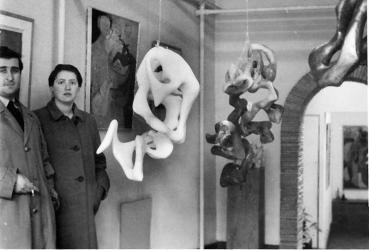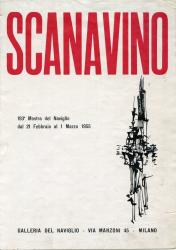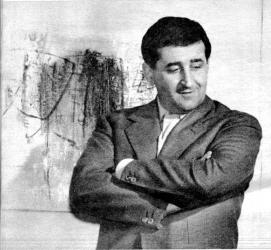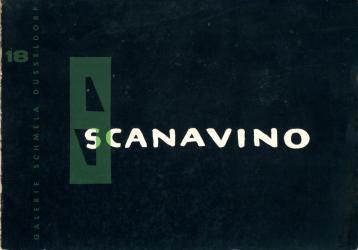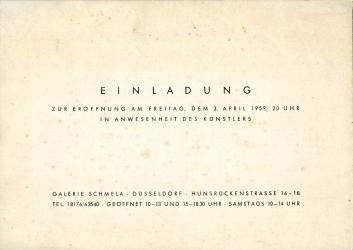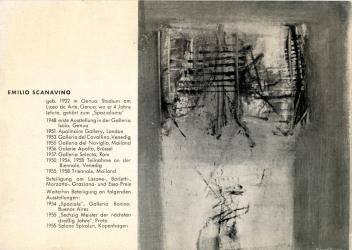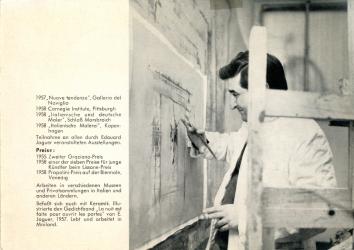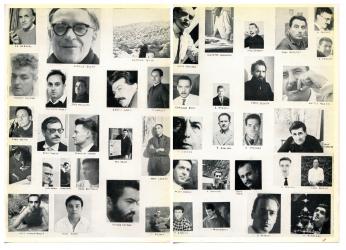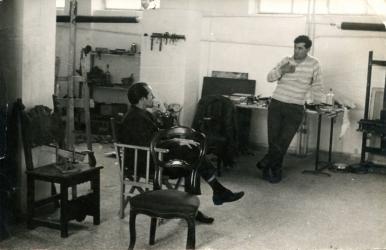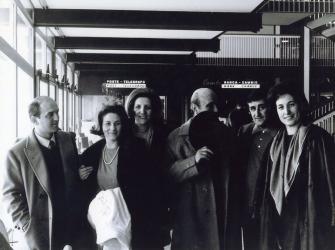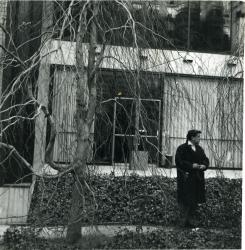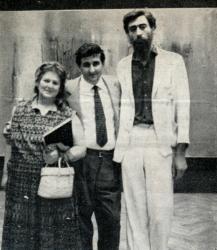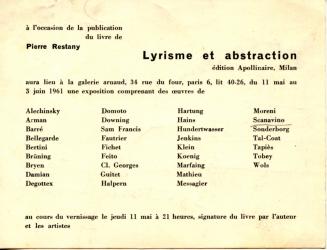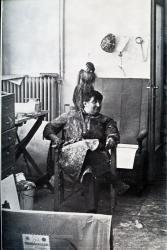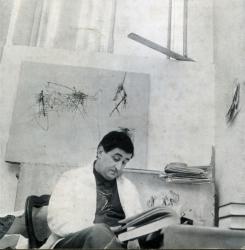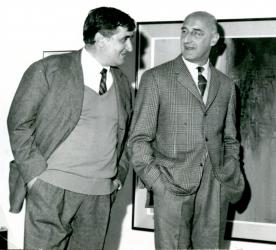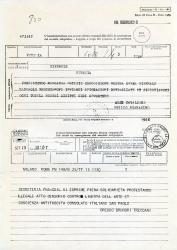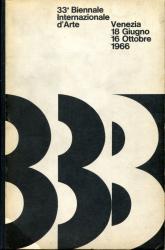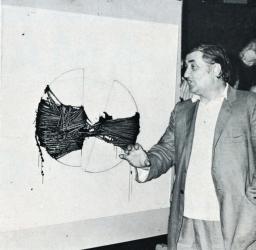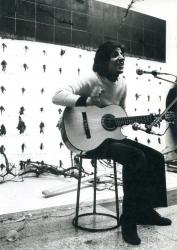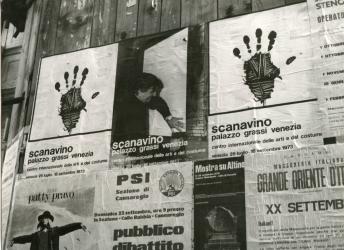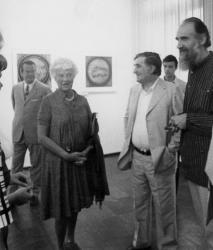1922
Emilio Scanavino was born in Genoa (Italy) on 28 February.
His father, Attilio Scanavino, was an accountant and belonged to a family of merchants who had lived for two generations in Salto Oriental, in Uruguay. Attilio returned to Italy during the Spanish flu pandemic of 1918, and volunteered to fight in WWI. Once back from the front lines, he married Maria Felicina Sterla.
For years, he worked as an importer of coffee from Brazil for Italian buyers (Associazione Commercio Caffé Droghe e Coloniali), but was very interested in philosophy and esotericism, collecting books in Portuguese, Spanish and Italian.
Emilio Scanavino, during his childhood – since his father was a victim of political persecution – could not play outdoors with other children, so he spent his days on the terrace of his home, building knick-knacks and small paper toys that he used to throw down in the courtyard below to the children freely playing there. He spent his days in the company of the doves living in the dovecote that his parents had built for him. This passion will remain with him, so much so that as an adult, he dedicated himself to collecting precious racing pigeons that he purchased in Belgium and in other cities abroad.
1934
For four years he attended the teacher training high school in Genoa with poor results.
His father would have liked to embark him on a cargo ship as a cabin boy to impart order and discipline on him, since Scanavino spent his time drawing and building “useless objects”.
1938
Asking his father for one last chance not to set sail, he expressed a desire to attend the Art High School in Genoa. This change stimulated his artistic abilities and aptitude, giving him a strong cultural spur. He approached the literature and poetry of writers such as Guillaume Apollinaire, André Gide, Jacques Prévert, Marcel Proust, Jean Paul Sartre, Federico García Lorca, Franz Kafka and Dylan Thomas.
At this school he met Giorgina Graglia, who became his wife in 1946.
1942-43
He graduated in June 1942, the year he also inaugurated his first solo exhibition at the Salone di Esposizione Romano, in Genoa, with a catalogue presentation by Luigi Bassano.
He began studying Architecture at the University of Milan, but was soon called to arms. On 8 September 1943 he was second lieutenant in Ancona. He left the army and found refuge on the mountains of the region of Liguria until the end of the conflict.
1945-47
After the end of the war, he worked as technical designer for Genoa’s Municipal Administration, a job that he would abandon to totally dedicate himself to painting.
He lived in a studio above the Mura dello Zerbino city wall, where he began to paint again.
In 1946 he took on a studio in Milan, an attic in Foro Bonaparte, and spent some time in and around Brera with the painters who met together at the famous Bar Jamaica. Here he met Lucio Fontana, Gianni Dova, Roberto Crippa, Sergio Dangelo, Piero Manzoni, Dadamaino and many others.
He started feeling the need to travel and, attracted by the French Impressionist School, left for Paris in August 1947, where he remained for some time, meeting critics, poets and artists the likes of Édouard Jaguer, Wols, Camille Bryen.
He visited the major art museums and was particularly fascinated by Rembrandt’s The Slaughtered Ox from 1655 exhibited at the Louvre.
Struck by Van Gogh’s palette, he returned to Italy with the desire to experience cadmium orange and his unique “flat” brushstroke.
Intrigued by Cubism, he analysed all of Picasso’s works, going from the figurative paintings to the Cubist paintings, trying, in vain, to meet him in his studio. He did, however, succeed in meeting Georges Braque.
1948
His Parisian experience was foundational for his stylistic development, in particular for the echoes of post-Cubism that he assimilated and interpreted in his own key, as shown in the works featured in his second solo exhibition at Galleria Genova and Galleria Isola accompanied by a catalogue featuring an essay by Enrico Ribulsi.
In this period, he participated in the cultural meetings organised on a weekly basis at the gallery, with people from the world of show business such as Elsa Albani, Ferruccio De Ceresa, Alberto Lupo and Damiano Chiesa, in addition to the poets Rocco Borella, Gianetto Fieschi, Rita Saglietto and others.
In 1948 he visited the Biennale di Venezia, the first of post-war times that also featured the Peggy Guggenheim collection.
1949-50
His son Sebastiano was born.
The following year he left his job at the Municipality of Genoa and totally dedicated himself to painting.
Starting in 1950, the artist entered into contact with Tullio Mazzotti and worked in his ceramics laboratory in Albisola.
He exhibited his work Soliloquio Musicale at the XXV Biennale di Venezia and attracted the attention of the critics. That same year, he received First Prize ex aequo at the V Mostra Regionale Genovese.
1951-52
He participated at the I Premio Borletti at Palazzina Borletti in Milan.
His first opportunity to present his work abroad: in May of 1951 at Apollinaire Gallery he held a solo exhibition together with American sculptress Sarah Johnson, whom he had been in contact with for a few years after having exhibited together in a group expo in 1949 in Florence, Ricostruzione del ponte di Santa Trinità mostra celebrativa, a commemorative celebration. On the occasion of his exhibition at the Apollinaire Gallery, he spent some time in London where he met many artists, among whom Phillip Martin, Eduardo Paolozzi and Graham Sutherland with whom he established lasting relationships. The exhibition was visited by and aroused the interest of Henry Moore, as written by a reporter from Il Secolo XIX newspaper in an article on 20 June 1951.
He was deeply impressed by the works of Francis Bacon, who left a strong mark in Scanavino.
In Tullio Mazzotti’s laboratory in Albisola, the strong rapport with the earth translated into the desire to work with clay, led him to meet many artists, some of whom he built a strong bond of friendship with. Among these: Lucio Fontana, Sebastían Matta, Guillame Corneille, Asger Jorn, Wilfredo Lam, Gianni Dova, Roberto Crippa, Enrico Baj, Sergio Dangelo, Giuseppe Capogrossi, Agenone Fabbri and Aligi Sassu.
Together with artists, he met and spent time with Jaguer and André Verdet, whom Scanavino had already met in Paris, where he continued to return even for short trips until 1958.
In Albisola he also met Carlo Cardazzo; at that time, he had already begun disseminating a new contemporary art circuit between Milan and Venice with a vanguard activity, presenting the first Spatial Environment by Fontana in his Galleria del Naviglio and organising the first European solo exhibition by Jackson Pollock.
A short time after their meeting, Cardazzo became his art dealer.
Scanavino obtained a full professorship chair for figurative arts and decorative sculpture at the Liceo Artistico “Nicolò Barabino” art high school in Genoa, where he taught for four years.
In 1952, Galleria del Naviglio and Galleria del Cavallino held the 2nd edition of the Premio Graziano prize and it was the first time that Scanavino exhibited in one of Cardazzo’s galleries.
The art critic and poet Guido Ballo began following his work.
Gallery owners Le Noci, Arturo Schwarz and Giuseppe Gastaldelli showed interest in his paintings.
His daughter Paola was born.
1953
Scanavino received the Premio Gaetano Ballardini prize at the XI Concorso Nazionale della Ceramica contest of Faenza and participated at the VIII Premio Lissone for painting.
His solo exhibition at Galleria del Cavallino in Venice, with a catalogue featuring a text by the painter Aligi Sassu, was his first monographic expo after the one in London.
He gravitated around the Milanese group of Spatialists – whose reference point is Galleria del Naviglio – without ever officially adhering to the intents of the movement.
1954
He was awarded a prize at the VIII Premio Michetti in Francavilla al Mare.
That summer, he participated in the first edition of Incontri Internazionali della Ceramica international meetings organised by Asger Jorn in Albisola, with Karel Appel, Corneille, Enrico Baj, Lucio Fontana and Sergio Dangelo.
He exhibited his ceramic works at Galleria del Cavallino in Venice in a solo exhibition organised by Carlo Cardazzo, and at Galleria Totti in Milan with a catalogue featuring a text by Tullio d’Albisola.
In Albisola, Scanavino met Mario Bardini, an architect with whom the artist collaborated by creating the external ceramic facade of the Chiosco del Fiore for the X Triennale di Milano, receiving the Silver Medal for ceramics from the jury.
He exhibited at the XXVII Biennale di Venezia.
His work was also featured in a group exhibition at Galleria Bonino, in Buenos Aires, and at the event Scanavino, Borella, Allosia, Baj, Fasce held at Galleria Numero in Florence.
1955
In February, Milan’s Galleria del Naviglio hosted a solo exhibition by Scanavino, presented through texts by Giampiero Giani, Rolan Giguère and the French critic Édouard Jaguer, founder of the Parisian movement and of the magazine called Phases. With Jaguer, Scanavino began an important relationship that later led them to develop exhibition and editorial projects together.
He exhibited at Boella, Fieschi, Mesciulam, Scanavino, at Galleria Rotta in Genoa.
That summer, Scanavino participated in Phases de l’art contemporain at Galérie Creuze in Paris.
Between December 1955 and January 1956, the V Premio Graziano prize was held at Galleria del Naviglio and the second recognition went to Scanavino and Ettore Sottsass ex aequo; the previous year, Sottsass had dedicated Scanavino an article on the magazine Domus.
1956
The artist’s international relationships flourished. The solo exhibition entitled Scanavino gouache et desseins held at Galerie Apollo in Brussels was presented through a catalogue text by Christian Dotremont, an emblematic figure connected to Gruppo CoBrA.
He participated at the exhibition Pittori d’oggi at Guido Le Noci’s Galleria Apollinaire in Milan, at the group exhibitions Spazialismo at Galleria del Naviglio, and Corneille, Scanavino, Vanderkam, Wolvecamp, W. Couzijn at Galerie Espace in Haarlem.
He participated as the sole Italian artist in This Is Tomorrow at the Whitechapel Gallery in London between August and September, invited by Anthony and Sarah Jackson, with whom he maintained a consistent relationship also after the joint solo exhibition of 1951.
The engineer Mario Bardini called him to intervene at Hotel Al Saraceno in Varigotti, and Fontana was also involved.
At the end of the year, he exhibited at the Troisième Exposition Internationale presented by Jaguer at the Galerie Kléber in Paris.
In the course of this year, he alternated his stay in Paris with short trips to London, where he again met Eduardo Paolozzi and the two became friends.
Scanavino was added to the publication by Giampiero Giani Spazialismo: origini e sviluppi di una tendenza artistica, published that year.
1957-59
He concluded his first contracts with Carlo Cardazzo and Peppino Palazzoli of Milan’s Galleria Blu.
He moved from Genoa to Milan and Enrico Crispolti, at the time a young critic who would become one of the major scholars of Italian and European Art Informel, began spending time in his studio in Milan, an attic in Via Tamburini.
Galleria d’Arte Selecta in Rome, ascribable to Cardazzo, hosted the solo exhibition Scanavino, presented through a text by Guido Ballo.
He participated in the exhibitions Peintres d’aujourd’hui. France-Italie at Palazzo delle Arti, inside Parco del Valentino public park, in Turin, and Artisti spaziali: Capogrossi, Crippa, Fontana, Scanavino at Galleria del Naviglio, Milan.
He received the X Premio Lissone Internazionale per la Pittura prize, and participated at the XI edition of La Triennale di Milano. That same year, he was present at Phases, the important event organised by the Stedelijk Museum in Amsterdam.
Carlo Cardazzo assured for himself the exclusive sale of his works.
He met Gillo Dorfles, Roberto Sanesi, Franco Russoli, Fernanda Pivano, Alain Jouffroy.
In 1957 he created the bas-relief for the Civil Engineering Dept. of the city of Imperia.
With Édouard Jaguer he published La nuit est faite pour ouvrir les portes, by Arti Grafiche Schenone.
He took part in some expos curated by Palma Bucarelli: Malerei des Jungen Italien at Fränkische Galerie in Nürnberg; Moderne Italiensk Maleri in Copenhagen; Pittori Tedeschi e Italiani Contemporanei at Galleria Nazionale d’Arte Moderna in Rome, which will be repeated at the Städtisches Museum Leverkusen in Oslo.
In 1958 he also exhibited at the expos The 1958 Pittsburgh International Exhibition of Contemporary Painting and Sculpture at the Carnegie Institute, and 20 Artistas Italianos de Hoy at the Museo Nacional de Bellas Artes in Buenos Aires.
He received the Premio Prampolini at the XXIX Biennale di Venezia.
In 1958 Carlo Cardazzo, with whom he had an exclusive rapport by now, presented the expo Incontro America-Italia at Galleria del Naviglio in Milan – a comparison between the new American art and its spearhead artists – featuring works by Kline, Rothko, Neuman, Norman Bluhm, Sam Francis and the Italians Capogrossi, Fontana, Crippa and Scanavino.
His trips to France continued and when he was in Paris, he spent time with Gianni Bertini, Dova, Corneille, Poujet and Jaguer.
In 1959 he held several solo exhibitions at Galleria del Naviglio in Milan, at Galerie Schmela in Düsseldorf and at Galleria del Cavallino in Venice, with catalogue and text by Umbro Apollonio.
His international activity continued: the exhibition Peintres et Sculpteurs Italiens: du Futurisme à nos jours at the Musée des Beaux Arts in Lyon; l’Exposition Boa Phases at the Museo de Bellas Artes in Santa Fe and the expo New Names in Italian Painting, I Magnin Italian Festival in Los Angeles. In addition to: Documenta II. Kunst nach 1945 (Malerei) at the Museum Fridericianum in Kassel, and the 11th Jahresausstellung der Neuen Darmstädter Sezession mit Italienischen Malern at the Institute Mathildenhöhe in Darmstadt.
He participated together with Capogrossi, Crippa and Fontana, in the expo 4 artistes spatialistes italiens at Galleria Kasper in Lausanne.
He was also present at the VIII Quadriennale d’Arte, at Palazzo delle Esposizioni, Rome, and at the XI edition of the Premio Lissone.
1960-61
He presented a solo exhibition in Brussels, at Galerie Aujourd’hui, at the Palais des Beaux Arts.
He was invited to the XXX Biennale di Venezia with a personal room in the central exhibition hall.
He won the Premio Spoleto, the Premio Sassari, the Premio Valsesia and the Premio Lignano prizes.
He travelled to the United States, visited New York and exhibited in The New Generation in Italian Art at the Museum of Fine Arts in Dallas. His work was on show also in France, in Paris, at Galerie Charpentier and at Galerie Internationale d’Art Contemporain.
Pierre Restany, interested in his work, included him in his publication Lyrisme et Abstraction published by Galleria Apollinaire in Milan. Scanavino takes part in the VI Tokyo Biennale, "The Japan International Art Exhibition", an international exhibition held at the Tokyo Metropolitan Art Museum in Ueno.
He participated in the group expo Anti-process presented first at Galerie des Quatre Saisons in Paris, giving him the chance to deepen his ties with French intellectuals Jean-Jacques Lebel and Alain Jouffroy.
He took part in the Italian venues of the exhibition, at Galleria Il Canale in Venice, in conjunction with the opening of the XXX Biennale di Venezia, and at Galleria Brera in Milan in June 1961. Together with him, participating artists were Baj, Bat-Josef, Bona, Bouvier, Brauner, Cazac, Corso, Crippa, Paolucci, Dado, Dorcely, Dova, Ferro, Guino, Harloff, Herold, Hiquily, Hundertwasser, Lam, Lebel, Le Toumellin, Licata, Lora, Manina, H. and P. Martin, Matta, Metcalf, Michaux, Mondino, Oppenheim, Penalba, Peverelli, André-Poujet, Quentin, Saby, Tancredi, Tinguely, Visieux, Zanartu.
This was also the year of his solo exhibitions at Galleria del Circolo di Cultura in Bologna and at Galleria del Cavallino in Venice.
He was once again recognised for an award at the XII Premio Lissone and took part in major expos of that decade: the VI Bienal de São Paulo, Brazil, Arte e contemplazione at Palazzo Grassi in Venice and Joung Italian Painters, at the Museum of Modern Art in Kamakua, Japan.
He was present at The Pittsburgh International Exhibition of Contemporary Painting and Sculpture, organised by the Department of Fine Arts of the Carnegie Institute and at the exhibition Dorazio, Garelli, Sanfilippo, Scanavino in Rome, at Gian Tomaso Liverani’s Galleria La Salita.
From 1960 to 1962 he produced his works in a studio – a basement located in Viale Legioni Romane in Milan, opposite the studio of the artist and friend Aricò.
1962
He purchased an old farmhouse in Calice Ligure and turned it into an atelier. There he spent a large portion of his time painting and sculpting.
He became friends with the collector Gianni Malabarba and with Professor Ugo Ruberti.
He inaugurated a solo exhibition in Rome, at Fabio Sargentini’s Galleria L’Attico, recommended to him by Enrico Crispolti already back in 1959, who curated the catalogue of the exhibition.
The subsequent expo was Assetto Capogrossi Scanavino, at the Joachim Gallery in Chicago. In March, his solo expo Scanavino: Opere Recenti was held at Galerie Internationale d’Art Contemporain in Paris. As was customary after the inauguration of an exhibition, all the artists used to meet at a restaurant, but that time, Carlo Cardazzo invited Scanavino and Giorgina to the Opéra in Paris for a concert by Juliette Gréco. Their absence caused discontent among fellow artists.
It was the year of his solo exhibition at Galleria del Cavallino in Venice with a catalogue featuring a text by Gillo Dorfles. The artist was also present at the I Mostra Internazionale organised by Galleria Bevilacqua la Masa in Venice and presented by Peggy Guggenheim.
That same year, he received the XVI Premio Michetti in Francavilla al Mare.
In conjunction with an expo organised by Finsider at the Sokolniki Park in Moscow in the spring of 1962 dedicated to the creations of Italian industry, Italsider sponsored a painting exhibition curated by Eugenio Carmi and Bruno Munari. Scanavino travelled to Russia for the occasion together with Cardazzo and other artists invited: Franco Gentilini, Edmondo Bacci, Giuseppe Capogrossi.
Alain Jouffroy dedicated an essay to him entitled La Questione S and other important writings in the years that follow.
1963
Scanavino was the protagonist of a series of national and international solo exhibitions: at Galleria del Naviglio in Milan, with a catalogue correlated by a poem by Dylan Thomas, at Galerie Smith in Brussels, at Galerie Birch in Copenhagen; in Genoa, at Galleria Rotta, with a catalogue featuring texts by Germano Beringheli and Alberto Martini.
In conjunction with an exceptional solo exhibition of the works of Joan Miró in Milan, presented by Carlo Cardazzo at Galleria Il Naviglio, Scanavino met the French artist who gave him the book curated by Jacques Dupin, Joan Miró, published by Il Saggiatore, Milan, adding a personal message. Knowing that Scanavino had created a laboratory for the production of ceramics, he suggested the use of the oven adopted by him, built exactly pursuant to the model of the ancient Korean ovens, fuelled exclusively by wood, because Miró retained that electric heaters were not suitable to obtain the desired results.
He received the Premio La Spezia Prize.
Carlo Cardazzo, who had supported Scanavino for seven years with the commitment of a friend, died suddenly. His passing caused the cancellation of the project he was working on to have Scanavino exhibit in New York.
Renato Cardazzo pursued his brother’s work and contributed to broadening Scanavino’s fame in Italy and abroad.
1964
The exhibition Emilio Scanavino was organised at Galleria del Cavallino in Venice, accompanied by a catalogue featuring texts by Renzo Guasco. This was followed by a solo exhibition at La Bussola gallery in Turin and by his presence at the group exhibitions Pittura a Milano dal 1945 al 1964, organised in the halls of Palazzo Reale in Milan, and Mario Sironi acht hedendaagse Italiaanse schilders, at the Museum Boijmans-Van Beuningen. He participated at the XIII Premio Nazionale di Pittura Francesco Michetti in Francavilla al Mare, at the Premio Marche 1964 and at the VIII Mostra Nazionale di Arti Figurative, in Ancona.
1965-67
In 1965, exhibitions Milan and in Verona were organised at Galleria del Naviglio, featuring a catalogue with texts by Guido Ballo, and at Galleria Ferrari with a text by Alessandro Mozzambani.
Scanavino was also present at the IX Quadriennale Nazionale d’Arte in Rome held at Palazzo delle Esposizioni, at the Biennale di San Marino at the Casinò Municipal de Cannes, taking part in the group exhibition L’art actuel en Italie.
For some time he lived and worked in Tradate. There he painted the works that he then exhibited at the XXXIII Biennale di Venezia in 1966, where he was invited with a personal showroom, an octagonal space designed together with the architect Scarpa, and won the Pininfarina Prize.
In the catalogue, the large canvasses on show were accompanied by an essay by Guido Ballo.
That same year, he exhibited at Galleria De’ Foscherari in Bologna with a catalogue featuring texts by Pietro Bonfiglioli, at Galleria Ferrari in Verona, and in the context of important group exhibitions: Aspetti dell’arte italiana contemporanea at Galleria Nazionale d’Arte Moderna, in Rome; Tokyo International Exhibition of Art in Japan; Graphic ’67 at the University of Kentucky, Lexington.
In 1967 he took part in international events such as the expo curated by Palma Bucarelli Exhibition of Contemporary Italian Art at the National Museum of Modern Art in Philadelphia. He was then present at the expo Five from Milan. Exhibition of Painting and Sculptures by Bonfanti, Cappello, Nangeroni, Scanavino, Volpini organised by the Philadelphia Art Alliance.
His works were also present at Il Museo Sperimentale di Torino, in the city’s Galleria Civica.
1968-69
He returned to Milan but increasingly resided in Calice Ligure, that became home to several artists who ended up building a small community around Scanavino, among them: Adami, Berkeley, Bertini, Bonalumi, Biasi, Cagnone, Camilli, Fabbri, Forrester, Icaro Lam, Lepiem, Mambor, Mariani, Marzé, Mitsuo Miyahara, Mondino, Nangeroni, Roth, Sarri, Stefanoni, Peverelli, Pinelli, Spadari, Jaques Trouvé, Verdet, Nanda Vigo and Turcato. Artists such as Phillip Martin and Andy Wahrol also came to Calice in the course of the years to visit him.
In 1968 – the year of the Fontana’s death – Necrologio per Fontana was born, testifying the great mutual esteem that bonded the two artists.
This was also the year of the three solo exhibitions accompanied by catalogues featuring texts by Cesare Vivaldi at Galleria Arco d’Alibert in Rome, at Galleria Il Punto in Turin and at Galleria del Naviglio in Milan.
He published his limited-edition book A mezzo della notte featuring 15 lithographies accompanying the seven poems by Gianni Malabarba. One of his poems was also featured in the catalogue of the expo Scanavino at Galleria Alberti in Omegna.
Another solo exhibition was held at Galleria La Bertesca, in Genoa.
He was once again invited to the XXXIV Biennale Internazionale d’Arte di Venezia.
In 1969, on the occasion of the event Naviglio incontri, Galleria Il Naviglio in Milan organised the exhibition Emilio Scanavino. Il reale occulto, accompanied by a catalogue featuring a text by Eligio Cesana, and additional solo exhibitions were offered him by Studio Sant’Andrea in Milan, and by Galleria Stefanoni in Lecco. He once again exhibited in France at the Palais de l’Europe in Menton, participating in L’Art graphique du XX Siècle, an expo dedicated to 20th-century graphic art.
1970
The New Smith Gallery in Brussels dedicated a solo exhibition to the artist.
He won first prize at the Palmarès Huitième at the VIII Biennale Internazionale d’Arte in Menton.
He participated in Dix Maîtres Italiens de la Peinture Contemporaine at the Chateau Musée in Cagnes sur Mer, and at the III Internationale der Zeichnung, at the Institute Mathildenhöhe in Darmstadt.
Franco Castelli, director of “L’Uomo e l’Arte” in Milan, became his friend and supporter.
In Calice Ligure he built a large new studio on his property where he worked until his death.
In the course of that same year, he purchased a home-studio in Rome that he used until 1974, near Piazza del Popolo, in Via del Babuino.
He bought a house in Paris in Rue de Rivolì 222 and took up a studio in the Arab area of the city.
In this period, he spent time with the entire entourage of Parisian and Italian artists in France, among whom Graham Sutherland, who later welcomed him in his villa in Menton and was, in turn, a guest in Calice Ligure several times.
He produced the editorial works Ipotesi dell’ospite inatteso and Un lavoro difficile together with Roberto Sanesi, who also curated some of the artist’s catalogues.
1971
In Rome, he established a working relationship with Arturo Zavattini, who became his friend, too.
He bought a house and a studio in Golfe Juan, near Vallauris, which gave him the chance to visit the museums and La Colombe d'Or, the famous rendezvous for artists on the Côte d'Azur. There he met André Verdet, one of the protagonists of French art and culture who, that same year, wrote one of the texts contained in the catalogue of the solo exhibition held at the Palais de l’Europe in Menton entitled Scanavino. 10 peintures.
He later became friends and collaborated with director Émile Marzé.
He visited Galerie Sapone in Nice that later hosted a solo exhibition of his.
In the spring, he participated in the representative expo of Italian art entitled 20 artistas italianos, at the Museo De Arte Moderno in Mexico City, exhibiting together with Adami, Alviani, Aricò, Baj, Carrino, Castellani, Ceroli, De Romans, Del Pezzo, Novelli, Dorazio, Pardi, Perilli, Parzini, Pistoletto, Pozzati, Romagnoni, Schifano and Tadini.
He created his large work Omaggio all’America Latina, a four-handed endeavour with the sculptor Alik Cavaliere, comprised of 156 elements each featuring the name of a martyr of freedom in South America in conjunction with the invitation to attend the XI Bienal de São Paulo in Brazil. The work was not exhibited due to a decision by the consular authorities, and was censured because the subject was retained to be of a political and hence extra-artistic nature. Back in Italy, the “retablo” became a symbol of freedom requested by public institutions, gallery owners and by the architecture students of the Università Statale di Milano for a demonstration with Giorgio Gaber.
The Scanavino. Io mani editorial project was born, with texts by Crispolti and Jouffroy and photos by Guido Cegani.
The artist also participated at the expos: Aspetti dell’Informale, held first at the Pinacoteca Provinciale in Bari, then at Palazzo Reale in Milan, and Adami, Errò, Phillip Martin, Scanavino at Studio Gastaldelli in Milan.
1972
He successfully recovered from a delicate operation for a circulatory condition and began a new creative phase of his painting.
This was the year of Omaggio all’America Latina. Emilio Scanavino e Alik Cavaliere, organised by Galleria De’ Foscherari in Bologna, and accompanied by a catalogue featuring texts by Enrico Crispolti.
He continued his activity in international centres such as the Neue Galerie der Stadt, the Wolfgang Gurlitt Museum in Linz, the Stadtmuseum in Wels, the Kulturamt der Landeshauptstadt in Klagenfurt.
He travelled to Belgium, France, Germany, the Netherlands, Switzerland, Austria, North America, Brazil, Venezuela, Mexico.
A study by Francesco De Bartolomeis was published: Il progetto dell’irrazionale di Emilio Scanavino, that introduced an innovative interpretation of the existential symbolism of his works.
1973-75
The Jetzt Kunsthalle in Darmstad dedicated a broad and in-depth anthology to Scanavino, born from the partnership with Bernd and Elisabeth Krimmel, curators of the catalogue, and then re-proposed in Italy, too, on two different occasions: in Venice at Palazzo Grassi and in Milan at Palazzo Reale.
In 1973, Scanavino was also invited to Der Grafiska Mediet inom den italienska avantgardismen, by the Italienska Kulturinstitutet C.M. Lerici of Stockholm.
At the X Quadriennale di Roma, for Situazione dell’arte non figurativa, he presented the large sequence of four paintings entitled Pittura.
In 1974 he exhibited at Palazzo Reale, in Milan, on the occasion of the exhibition La ricerca dell’identità, with a catalogue featuring texts by Gianfranco Bruno.
In 1975, the anthological exhibition Emilio Scanavino was organised at Levy Galerie in Hamburg. He held the solo exhibition Scanavino, pitture ed acrilici su cartone at Galerie La Pochade in Paris. He participated at the X Quadriennale di Milano.
1976
He established a friendship and work relationship with Giorgio Marconi.
This was the year of the expo Scanavino at Galleria Editalia in Rome, with a catalogue that included an essay by Giulio Carlo Argan, and a solo exhibition in Udine, at Valentino and Anna Turchetto’s Galleria Plurima. The artist was then present at the exhibitions L’esperienza moderna 1957-1959, organised at the Marlborough Gallery in Rome, and L’Immagine Altra, Rassegna di Pittura e Scultura Astratta, at the Antichi Arsenali delle Repubblica, in Amalfi.
1977-78
Studio Marconi in Milan inaugurated the grand exhibition Scanavino. La porta, il viaggio, accompanying the expo with a catalogue featuring a text by Roberto Sanesi. The initiative was repeated at the Galleria Civica di Arte Moderna, at the Castello di Portofino, and this time the catalogue was curated by Bernd Krimmel. Then came the solo exhibition at Galleria Marin in Turin, and the group expos Pittura Italiana 1950-1970, at Villa Malpensata in Lugano and Italienische Malerei 1950-1970 at the Künstlerhaus in Vienna.
He alternated his activity between Paris and Italy.
In 1978 Franco Russoli and Giulio Carlo Argan wrote the texts of the catalogue of the exhibition Emilio Scanavino organised at the Centro Culturale Olivetti in Ivrea.
1979-80
He exhibited at Galerie Mathias Fels in Paris with a solo event featuring a catalogue and text by Roberto Sanesi.
Then at Galleria Cesarea, in Genoa, where a solo exhibition was organised, accompanied by a catalogue featuring a contribution by Germano Beringheli, and at Galleria Plurima in Udine. A selection of works was also present in Lisbon at the Gravura abstracta italiana, Galeria de exposições temporárias.
In 1980 he held solo exhibitions at Galleria Giuli, in Lecco, at the Padiglione d’Arte Contemporanea di Parco Massari in Ferrara, and the Mercato del Sale in Milan.
He left Paris for health reasons.
1981-83
The exhibition Emilio Scanavino was organised at Studio Gastaldelli in Milan (catalogue featuring a text by Alberto Galimberti) and this was also the year of the expo events Il materiale delle arti. Processi tecnici e formativi dell’immagine at the Castello Sforzesco, in Milan, and Linea della ricerca artistica in Italia at Palazzo delle Esposizioni in Rome.
In 1982 the international expo of contemporary art at Castello Aragonese in Ischia was dedicated to the work of the artist. The catalogue contained texts by Gerardo De Simone, Giulio Carlo Argan, Vitaliano Corbi, Giorgio di Genova, Gino Grassi, Aldo Passoni and Franco Russoli.
He lived between Calice Ligure and Milan. Despite the progressive worsening of his health conditions, he continued to work intensely and to exhibit in public and private venues.
In this last period, he was aided by Mario Valente.
The following year Scanavino participated at the exhibition Informale in Italia, dedicated to Francesco Arcangeli and curated by Renato Barilli and Franco Solmi at Galleria d’Arte Moderna in Bologna.
1984-85
He exhibited a series of ceramic works at the Museo della Ceramica in Albisola Mare and a solo exhibition was hosted at Galleria Morone in Milan.
A solo exhibition was held in Florence at Palazzo dei Congressi and in the summer he exhibited at the Château de Tours in France together with Dorazio, Nangeroni, Fraccari, Pulini, Pozzati and Marchionni.
At the Limonaia of the Palazzo dei Congressi in Florence, the expo Emilio Scanavino. Il segno del tempo was organised.
1986
Emilio Scanavino died in Milan on 28 November.


